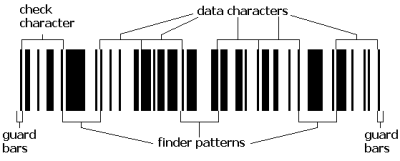Each barcode consists of up to 74 numerals or 41 alphabetic characters. The string is encoded as a binary number and the first bit is simply a flag indicating whether or not the barcode is part of a composite barcode.
The height of the barcode is at least 34 modules, and the width varies from 53 to 543 modules. Each barcode begins and ends with two one-module wide guard bars, the left pair is always space-bar and the right one is always bar-space. Following this is one or more (up to a maximum of 11) triplets each of which contains a finder pattern between two data characters. (But the first data character of the first triplet is actually a check character and, if there are an odd number of data characters, then the last "triplet" does not have second data character. It does have a finder pattern.)
Each of the data characters is of 17 modules with 4 bars and 4 spaces. The finder patterns are 15 modules. Each has 5 bars and spaces, total.

The bars and spaces of the right-most of the two data characters in any given triplet are read right-to-left.

